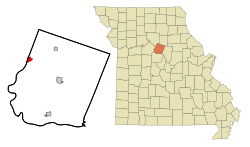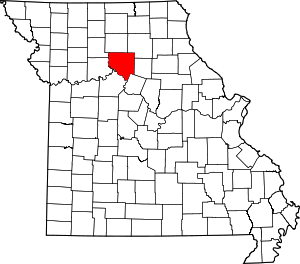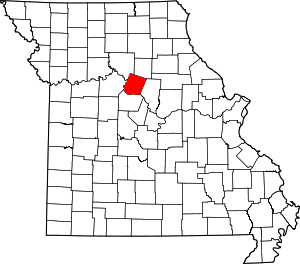Glasgow, Missouri
Glasgow is a city on the Missouri River mostly in northwest Howard County and extending into the southeast corner of Chariton County in the U.S. state of Missouri. The population was 1,103 at the 2010 census.
Glasgow, Missouri | |
|---|---|
.jpg) 1st Street in Glasgow | |
 Location of Glasgow, Missouri | |
| Coordinates: 39°13′38″N 92°50′48″W[1] | |
| Country | United States |
| State | Missouri |
| Counties | Howard, Chariton |
| Area | |
| • Total | 1.42 sq mi (3.67 km2) |
| • Land | 1.30 sq mi (3.38 km2) |
| • Water | 0.11 sq mi (0.30 km2) |
| Elevation | 673 ft (205 m) |
| Population | |
| • Total | 1,103 |
| • Estimate (2019)[4] | 1,084 |
| • Density | 831.29/sq mi (320.89/km2) |
| Time zone | UTC-6 (Central (CST)) |
| • Summer (DST) | UTC-5 (CDT) |
| ZIP code | 65254 |
| Area code(s) | 660 |
| FIPS code | 29-27208[5] |
| GNIS feature ID | 0718486[1] |
| Website | City website |
.jpg)
.jpg)
The Howard County portion of Glasgow is part of the Columbia, Missouri Metropolitan Statistical Area.
History
Glasgow was laid out and platted in 1836, partially from land acquired from former Missouri State Treasurer James Earickson[6][7] The city was named for James Glasgow, a local merchant.[8] A post office called Glasgow has been in operation since 1837.[9]
The Battle of Glasgow was fought on October 15, 1864, in and near Glasgow as part of Price's Missouri Expedition during the American Civil War. Although the battle resulted in a Confederate victory and the capture of significant war material, it had little long-term benefit as Price was ultimately defeated at Westport a week later, bringing his campaign in Missouri to an end.[10]
There is a historical record of extrajudicial violence. On January 20, 1891, an African American man, Olli Truxton, was killed by a white lynch mob in Glasgow.[11] On August 3, 1891, an African American man, Harrison Mickey, was killed by a black lynch mob in Glasgow.[12][13]
The Campbell Chapel African Methodist Episcopal Church, Glasgow Commercial Historic District, Glasgow Presbyterian Church, Glasgow Public Library, and Inglewood are listed on the National Register of Historic Places.[14]
Geography
The city is on the bank of the Missouri River. It is served by Missouri routes 5, 87 and 240. Greggs Creek flows past the south side of the community.[15]
According to the United States Census Bureau, the city has a total area of 1.42 square miles (3.68 km2), of which 1.30 square miles (3.37 km2) is land and 0.12 square miles (0.31 km2) is water.[16]
Demographics
| Historical population | |||
|---|---|---|---|
| Census | Pop. | %± | |
| 1860 | 1,035 | — | |
| 1870 | 1,795 | 73.4% | |
| 1880 | 1,841 | 2.6% | |
| 1890 | 1,781 | −3.3% | |
| 1900 | 1,672 | −6.1% | |
| 1910 | 1,607 | −3.9% | |
| 1920 | 1,351 | −15.9% | |
| 1930 | 1,409 | 4.3% | |
| 1940 | 1,490 | 5.7% | |
| 1950 | 1,440 | −3.4% | |
| 1960 | 1,200 | −16.7% | |
| 1970 | 1,336 | 11.3% | |
| 1980 | 1,336 | 0.0% | |
| 1990 | 1,295 | −3.1% | |
| 2000 | 1,263 | −2.5% | |
| 2010 | 1,103 | −12.7% | |
| Est. 2019 | 1,084 | [4] | −1.7% |
| U.S. Decennial Census[17] | |||
2010 census
As of the census[3] of 2010, there were 1,103 people, 458 households, and 277 families living in the city. The population density was 848.5 inhabitants per square mile (327.6/km2). There were 533 housing units at an average density of 410.0 per square mile (158.3/km2). The racial makeup of the city was 89.8% White, 7.9% African American, 0.1% Native American, 0.3% Asian, and 2.0% from two or more races. Hispanic or Latino of any race were 1.5% of the population.
There were 458 households, of which 29.3% had children under the age of 18 living with them, 46.7% were married couples living together, 9.0% had a female householder with no husband present, 4.8% had a male householder with no wife present, and 39.5% were non-families. 35.4% of all households were made up of individuals, and 15% had someone living alone who was 65 years of age or older. The average household size was 2.31 and the average family size was 3.00.
The median age in the city was 41.9 years. 25.7% of residents were under the age of 18; 6.1% were between the ages of 18 and 24; 21.7% were from 25 to 44; 28% were from 45 to 64; and 18.5% were 65 years of age or older. The gender makeup of the city was 47.2% male and 52.8% female.
2000 census
As of the census[5] of 2000, there were 1,263 people, 495 households, and 317 families living in the city. The population density was 946.1 people per square mile (366.7/km2). There were 562 housing units at an average density of 421.0 per square mile (163.1/km2). The racial makeup of the city was 89.87% White, 8.47% African American, 0.16% Native American, 0.08% Asian, 0.63% from other races, and 0.79% from two or more races. Hispanic or Latino of any race were 0.79% of the population.
There were 495 households, out of which 33.5% had children under the age of 18 living with them, 50.1% were married couples living together, 10.9% had a female householder with no husband present, and 35.8% were non-families. 33.3% of all households were made up of individuals, and 16.6% had someone living alone who was 65 years of age or older. The average household size was 2.45 and the average family size was 3.14.
In the city the population was spread out, with 27.2% under the age of 18, 7.8% from 18 to 24, 25.7% from 25 to 44, 20.0% from 45 to 64, and 19.3% who were 65 years of age or older. The median age was 38 years. For every 100 females, there were 87.1 males. For every 100 females age 18 and over, there were 83.8 males.
The median income for a household in the city was $30,242, and the median income for a family was $36,806. Males had a median income of $24,188 versus $17,130 for females. The per capita income for the city was $14,544. About 7.1% of families and 10.8% of the population were below the poverty line, including 15.6% of those under age 18 and 11.2% of those age 65 or over.
Education
Public education in Glasgow is administered by Glasgow School District which operates one elementary school, one middle school and Glasgow High School.[18]
Glasgow has a lending library, the Lewis Library Of Glasgow.[19]
Notable people
- John Wesley Donaldson (1891 – 1970), born in Glasgow, was an American baseball pitcher, whose career spanned over 30 years and included many different Negro league baseball teams.
- Harry H. Vaughan (1893-1981), military aide to Harry S Truman
References
- U.S. Geological Survey Geographic Names Information System: Glasgow, Missouri
- "2019 U.S. Gazetteer Files". United States Census Bureau. Retrieved July 26, 2020.
- "U.S. Census website". United States Census Bureau. Retrieved 2012-07-08.
- "Population and Housing Unit Estimates". United States Census Bureau. May 24, 2020. Retrieved May 27, 2020.
- "U.S. Census website". United States Census Bureau. Retrieved 2008-01-31.
- Missouri State Treasurer-Past Treasurers Biography
- Earngey, Bill (1995). Missouri Roadsides: The Traveler's Companion. University of Missouri Press. p. 101.
- Eaton, David Wolfe (1916). How Missouri Counties, Towns and Streams Were Named. The State Historical Society of Missouri. p. 175.
- "Post Offices". Jim Forte Postal History. Archived from the original on 9 October 2016. Retrieved 8 October 2016.
- Battle Summary: Glasgow, MO, archived from the original on December 3, 2009
- NAACP (1919). Thirty Years of Lynching in the United States, 1889—1918. NAACP. p. 80.
- "A MURDERER QUICKLY LYNCHED". New York Times: 1. August 4, 1884. Retrieved 20 August 2018.
- "A Colored Pic-Nic". McCook Weekly Tribune: 2. August 14, 1884. Retrieved 20 August 2018.
- "National Register Information System". National Register of Historic Places. National Park Service. July 9, 2010.
- Missouri Atlas & Gazetteer, 1998, Delorme p.30 ISBN 0-89933-224-2
- "US Gazetteer files 2010". United States Census Bureau. Archived from the original on 2011-02-20. Retrieved 2012-07-08.
- "Census of Population and Housing". Census.gov. Retrieved June 4, 2015.
- "Glasgow School District". Great Schools. Retrieved 2 June 2019.
- "Missouri Public Libraries". PublicLibraries.com. Archived from the original on 10 June 2017. Retrieved 1 June 2019.
External links
- City of Glasgow
- Historic maps of Glasgow in the Sanborn Maps of Missouri Collection at the University of Missouri
- Historic photographs of Glasgow in the Prints and Photographs Division of the Library of Congress

